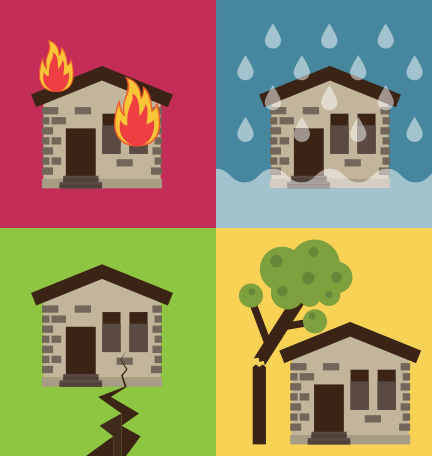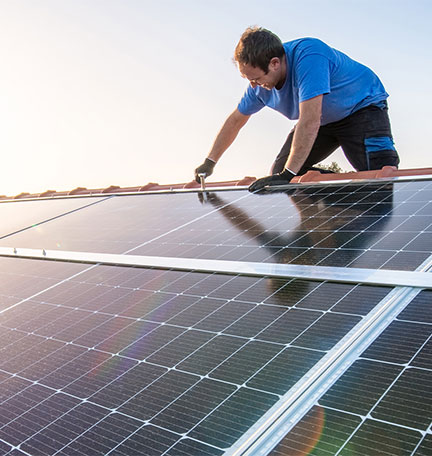Eco-home improvements offer financial as well as ecological benefits, and they’re easier to finance than you may think.
Quick—how much did you spend last year on heating and cooling your home? Whatever the number, your first reaction is probably “too much.”
And with good reason. The average monthly residential bill for electricity alone in 2022 was $137, or $1,644 for the year, says the U.S. Energy Information Administration. What if you could reduce your home utility costs? And reap additional benefits? And easily finance the work?
Turns out, you can. Here’s how.
Benefits of Eco Upgrades
Yes, some eco-friendly improvements carry higher upfront price tags. But they also come with these benefits.
- Tax incentives. “Early solar adopters were focused on environmental impact—it wasn’t a financial decision,” says Joel Cannon, SVP of Sales and Marketing at EnerBank, a division of Regions that makes home-improvement loans. But tax credits implemented in 2005 were a game changer, he says, and they continue to be offered at the federal, state and local levels. In fact, 2022’s Inflation Reduction Act includes nearly $9 billion in incentives and rebates for residential upgrades.
- Lower utility bills. Putting the sun to work powering your home, installing more efficient HVAC systems and decreasing the draftiness of your windows are all improvements that will help lower your monthly payments by up to 20% to 30%, according to one estimate.
- Ecological benefits. Energy-efficient upgrades can minimize emissions, decrease your carbon footprint and conserve resources. They could even improve the air quality inside your home.
- Greater curb appeal. “Buyers used to be agnostic about acquiring a home with solar,” says Tracy Jackson, SVP of Lending at Regions. Not anymore. Buyers are now actively seeking homes with sustainable features, knowing that they can help keep utility costs down, according to the National Association of Home Builders. And 63% of Realtors surveyed last year said that promoting energy efficiency in their listings was “very or somewhat valuable.”
Eco Upgrades to Make
While upfront costs and potential savings can vary widely by geographical region—and, of course, by the scope and complexity of the work—here are some solid choices to consider.
This list includes what might be considered major upgrades and a few of the less intensive options. The types of projects you should take on will always depend on your budget.
- Solar panels. Also known as photovoltaic panels, these sunshine collectors that sit atop your roof or in your yard convert rays into energy that can help power your home and lower your electric bill. The price tag to install them will vary based on what option you choose like different types of panels and shingles or the Tesla Solar Roof. And while upfront costs can be high, a new system could be eligible for a 30% tax credit.
- Tankless water heaters. Storage water heaters keep water hot whether you need it or not. Go tankless, though, and water is heated up only as you need it—an on-demand design that’s up to 34% more efficient than traditional heaters. Install one for a single tap or the whole house.
- High-efficiency HVAC equipment. Heating and cooling can make up about half of a home’s energy usage. And since newer systems require less run time, they can reduce energy usage by up to 50%, making for a big potential payoff. The change can also result in better air quality, more precise temperature control, less noise and fewer repairs.
- Geothermal heat pumps. Traditional systems heat and cool air by exchanging it with the outdoors—an especially big task with extreme temperatures. But geothermal heat pumps exchange heat with the earth just below its surface, where the temperature remains relatively steady, allowing them to use 25% to 50% less electricity than conventional systems.
- Dual-pane windows. Regular windows can seem like a sieve, letting warm air out and cold air in. Upgraded panels add another layer of glass and fill the space in between with an insulating gas. As a result, your heating and cooling systems won’t have to work as hard. Bonus: These windows now qualify for up to $600 in annual tax credits.
- Smart lights. LED lights make for an easy way to cut electric costs, as they use at least 75% less energy and last up to 25 times longer than incandescent lighting. Some come with motion-detecting sensors or as part of a smartphone-operated system.
- Smart thermostats. These can be “the best candidate to save energy in your home,” says the Department of Energy. After all, why keep your home at the perfect temperature when you’re not there? By making adjustments automatically or letting you do so from your phone, smart thermostats can save you up to 10% on heating and cooling costs.
How to Finance It
Eco-home improvements offer yet another benefit: easy-to-secure financing that can help you take advantage of tax incentives and may be available through an approved contractor.
When you hire a contractor who’s authorized to work with a lender like EnerBank, they can take your loan application right from your home. And because home-improvement loans are typically unsecured (meaning you don’t have to put up collateral), closing is fast—sometimes instantaneous.
“Working with contractors offers a better rate-and-term combination than people can typically source on their own, especially with an unsecured loan,” says EnerBank’s Cannon. “Plus, the loan proceeds go straight to the contractor at the end of the job, so there’s no need for cash up front.” Another upside: Because some of these loans take the tax credits for home upgrades into account, your payments may be lower (see examples below).
You may have a couple of options for how these loans are structured.
- Same-as-cash loans. If you’re expecting, say, a 30% tax credit on your solar panel installation, these loans give you time to file your taxes, recoup the funds via a refund and apply your tax savings to the loan before paying any interest on that portion of the balance. You may also have the opportunity to later apply other savings to the loan and lower your monthly payments.
- Level pay loans. These loans give you the benefit of the tax credit upfront. By assuming that you’ll apply the tax credit at some point over the loan’s term, the loan is for less than the full cost of the project, lowering your monthly payments.
Three Things to Do
- Review additional options for home improvement financing, including HELOCs and loans.
- Learn more about EnerBank’s contractor financing, including how it works and what the benefits are.
- Read about four home improvement projects that can increase your home’s value.











